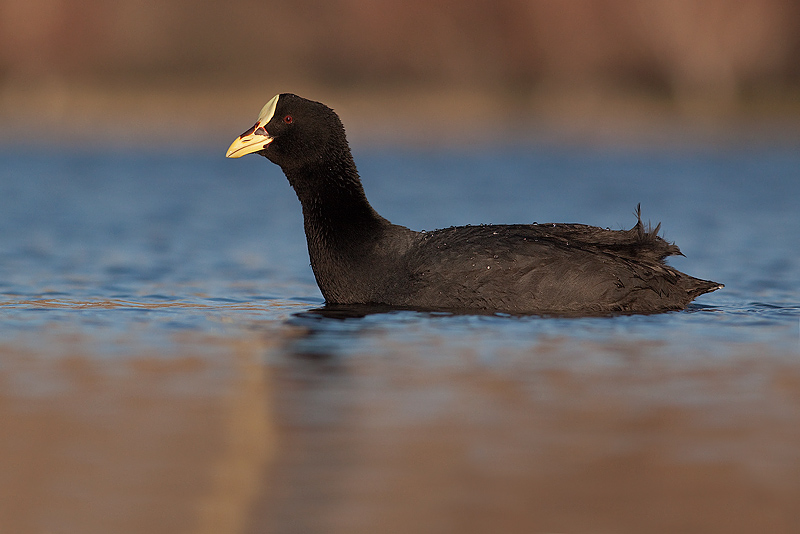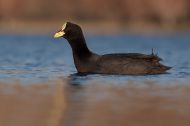Red-gartered Coot
Gallareta de Ligas Rojas
Fulica armillata
Length: 450mm. Sexes alike. Bill and frontal shield pale yellow; on upper ridge and at the base on sides of maxilla and mandible show chestnut red spots; iris red; head and neck black; back, scapulars, uppertail coverts and rectrices above slate-grey; wing coverts slate-grey; primaries and secondaries brownish grey; the outer primary shows its outer vexilla with a thin white margin; underwing coverts and axillaries brownish grey; breast, flanks and abdomen slate-grey, lighter and faintly edged with whitish on the abdomen; undertail coverts white with blackish centre; legs with bare part of tibia chestnut red; tarsi green with reddish tinge; toes yellowish green darker on joints and on lobes.
Juveniles: brownish grey on upperparts and wings; underparts pale ashy grey washed with brownish and speckled with white; head and neck whitish mottled dark brown on top of head and hind neck; the bill, with greatly reduced frontal shield that is olive brown, slightly yellowish towards the tip.
It is distinguished from the rest of the coots that occur in our region by being the largest and having a frontal yellow shield that is oval ending in a point; the spots at the base of the bill and the red on the tibia are also helpful.
Habitat and behaviour: gregarious, it can be found in scattered groups and in vast flocks of hundreds of individuals; it resides in ponds, lakes, rivers, streams and marshes. It frequents environments both with and without emergent aquatic vegetation. Very good swimmer and diver. Flies well but in taking wing it patters along surface while getting under way. Not infrequently seen out of the water eating tender grass. To get away from danger it prefers to swim, but if the threat is serious it taxis along with the aid of strong wing beats; to move from one place to another it generally flies at night, when its natural enemies do not pose a threat.
Although quite tame, among them they are rather hostile and are often seen engaging in fights and disputes; they are aggressively territorial during the breeding season driving away both individuals of its species and other coots, and also ducks and other aquatic birds.
It feeds both on the surface of the water and diving. Its diet consists of shoots, stems, leaves and seeds of marshy plants, as well as filamentous algae. It builds a floating nest of reeds. In those ponds lacking reeds, it uses plants anchored to the bottom both to build the nest and to fasten it. The usual clutch contains up to seven eggs, buff cream or brownish mottled profusely with purple chestnut. Both sexes incubate and look after the chicks. Hatchlings are covered with a black down with top part of head brightly coloured and featherless; the chin, throat and neck also show a bright orange colour. Range: widely distributed throughout Patagonia from Neuquén and Río Negro to Tierra del Fuego, occasionally reaching Islas Malvinas; also on almost the entire Argentina, except for the high plateau in Jujuy, in Formosa and Misiones. It also occurs in Chile, Uruguay, Paraguay and southeast Brazil.
Illustrated Handbook of the Birds of Patagonia
Kindless: Kovacs Family
|









